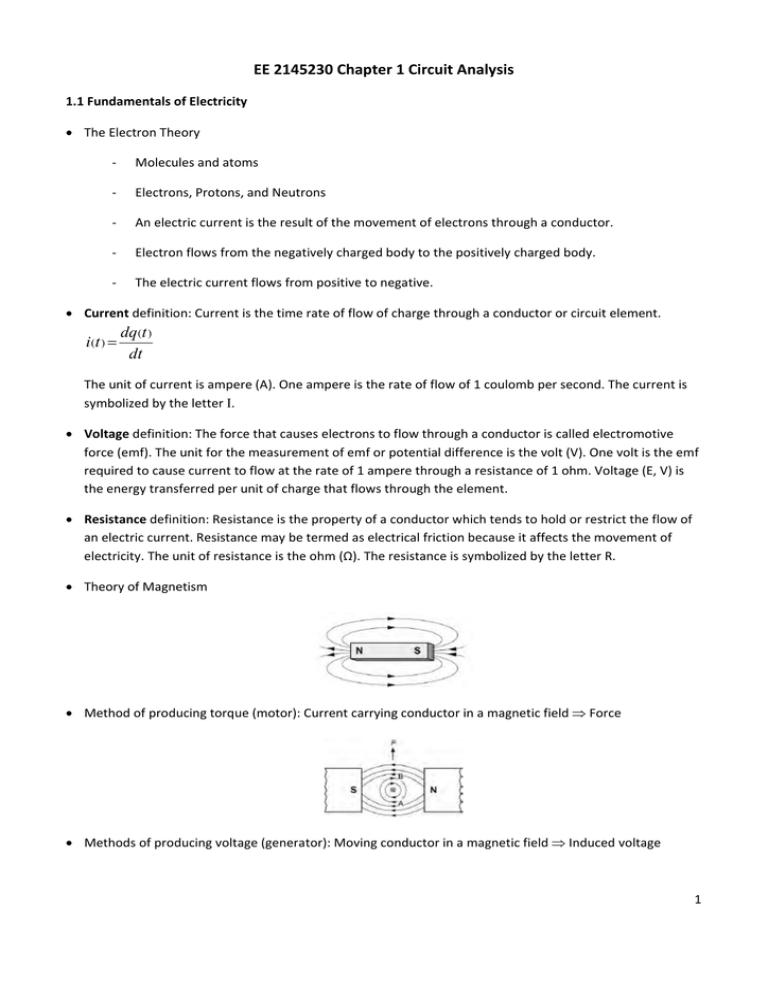Ch 1 Circuit Analysis
advertisement

EE 2145230 Chapter 1 Circuit Analysis 1.1 Fundamentals of Electricity • The Electron Theory ‐ Molecules and atoms ‐ Electrons, Protons, and Neutrons ‐ An electric current is the result of the movement of electrons through a conductor. ‐ Electron flows from the negatively charged body to the positively charged body. ‐ The electric current flows from positive to negative. • Current definition: Current is the time rate of flow of charge through a conductor or circuit element. i (t ) = dq (t ) dt The unit of current is ampere (A). One ampere is the rate of flow of 1 coulomb per second. The current is symbolized by the letter Ι. • Voltage definition: The force that causes electrons to flow through a conductor is called electromotive force (emf). The unit for the measurement of emf or potential difference is the volt (V). One volt is the emf required to cause current to flow at the rate of 1 ampere through a resistance of 1 ohm. Voltage (E, V) is the energy transferred per unit of charge that flows through the element. • Resistance definition: Resistance is the property of a conductor which tends to hold or restrict the flow of an electric current. Resistance may be termed as electrical friction because it affects the movement of electricity. The unit of resistance is the ohm (Ω). The resistance is symbolized by the letter R. • Theory of Magnetism • Method of producing torque (motor): Current carrying conductor in a magnetic field ⇒ Force • Methods of producing voltage (generator): Moving conductor in a magnetic field ⇒ Induced voltage 1 1.2 Ohm’s Law • The current in an electric circuit is directly proportional to the emf (voltage) and inversely proportional to the resistance. 1 volt causes 1 ampere to flow through a resistance of 1 ohm. 1.3 Resistive Circuits Analysis using Series and Parallel Equivalents • Replace series and parallel combinations of resistances by equivalent resistances • There are two possible connections: 1) Series ‐ same current flows 2) Parallel ‐ same voltage drop If there are two resistances, Req = R1 R2 R1 + R2 2 • Example 1 Equivalent resistance • Exercise 1 Find equivalent resistances 3 • Example 2 Find current, voltage and power for each element of the circuit 4 • Exercise 2: Find current values Solutions: (a) i1 = 1.04 A, i2 = 0.48 A, i3 = 0.32 A, i4 = 0.24 A (b) i1 = i2 = 1 A (c) i1 = 1 A, i2 = 0.5 A, i3 = 0.5 A 1.4 Kirchhoff’s Laws • Law 1 (KCL): In a parallel circuit, the algebraic sum of the currents entering a point is equal to the algebraic sum of currents leaving that point. • Law 2 (KVL): In a series circuit, the algebraic sum of the voltage drop in that circuit must be equal to the source voltage Asst. Prof. Thavatchai Tayjasanant, Ph.D. 5

